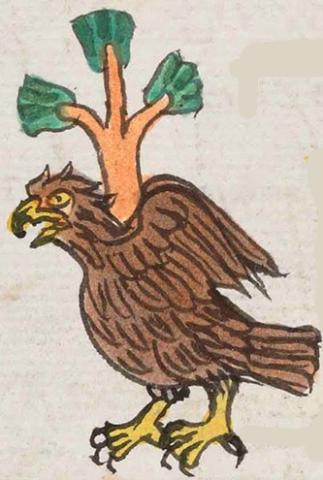Cuauhhuacan (Mdz5v)
This compound glyph for the place name Cuauhhuacan has two principal elements, a tree (cuahuitl) and an eagle (cuauhtli). The tree is a standard cuahuitl, with a leader and two side branches, each one of the three parts with two-tone green foliage. The bark is a terracotta color. The eagle is brown in color, with a yellow beak, legs, eye, and feet. It is a full body, standing, with wings slightly raised, facing to the viewer's left. Its beak is open.
Stephanie Wood
The -hua- element is a possessor, refering to the place (-can) that has a certain thing. The tree is what Gordon Whittaker, in Discovering Aztec Hieroglyphs, 2021, 90, calls a phonetic indicator for the word for eagle(s). The vowel length is different, but both words have approximately the same stem "cuauh" (see Karttunen's discussion of this). Thus, the tree may serve to provide a reinforcement of the reading "eagle" (over some other kind of bird).
Cuahuacan province covers the mountainous area between the valleys of Mexico and Toluca.
Stephanie Wood
quaguacan / puo
Cuauhhuacan, pueblo (Cuahuacan today)
Stephanie Wood
c. 1541, or by 1553 at the latest
Stephanie Wood
Both the top element, [cuahuitl, tree], and the lower element [cuauhtli, eagle], have the same stem "cuauh," and either one could be read first with the other one serving as a phonetic reinforcement.
eagles, trees, águilas, árboles, Quahuacan, Quaguacan, Cuahuacan, nombres de lugares

cuahui(tl), tree, https://nahuatl.wired-humanities.org/content/cuahuitl-1
cuauh(tli), eagle, https://nahuatl.wired-humanities.org/content/cuauhtli
-hua- (possessive), https://nahuatl.wired-humanities.org/content/hua
-can (locative suffix), https://nahuatl.wired-humanities.org/content/can-2
Karttunen agrees that this glyph could be read either of the two ways provided by Berdan and Anawalt. She adds that it would depend upon the vowel length, with the cuauh- for eagle having a long a and the cuauh- for tree having a short a.
"Place Where They Have Trees" or "Place Where They Have Eagles" (Berdan and Anawalt, 1992, vol. 1, 200)
cuauhCUAUH2
Codex Mendoza, folio 5 verso, https://digital.bodleian.ox.ac.uk/objects/2fea788e-2aa2-4f08-b6d9-648c00..., image 21 of 188.
The Bodleian Libraries, University of Oxford, hold the original manuscript, the MS. Arch. Selden. A. 1. This image is published here under the UK Creative Commons, “Attribution-NonCommercial-ShareAlike 3.0 License” (CC-BY-NC-SA 3.0).



